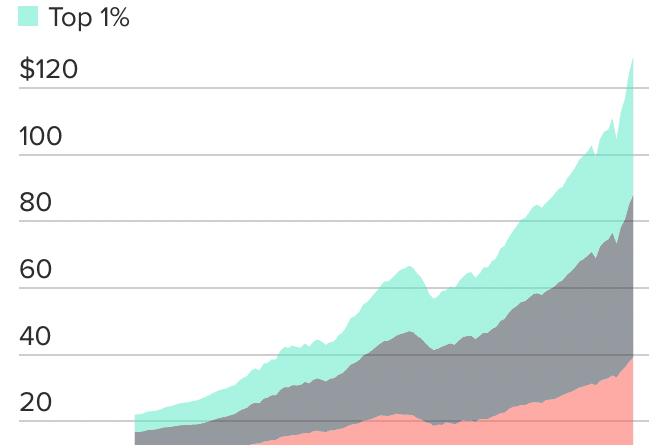Behar 5782 – Jubilee and Income Inequality
The yovel, or jubilee year offers an amazing vision for how a society should be structured.
Benjamin talked about how the shmita and jubilee years show the importance of tzedakah, which is true, but the jubilee year goes way beyond that – by including not only remission of debts, but a requirement that all land revert to its original owners, it’s a powerful countermeasure to income inequality – an issue that is incredibly important to us today.
We often hear talk of the “1%,” the top 1% of earners. In Canada, 1% of the population earns over $685,000 a year. I’m sure to most of us that sounds like a lot. But the biggest problem with income inequality isn’t the 1%, it’s the handful of people at the very top of the pyramid, the fraction of 1 percenters.
Since the start of the COVID pandemic, the world’s 10 richest men – and the top ten are all men – more than doubled their collective fortunes, from $700 billion to $1.5 trillion. Meanwhile, the incomes of 99% of the world population went down. The 10 richest men control six times more wealth than the bottom 40% of the global population, 3.1 billion people. Let that sink in a moment: ten people control six times more wealth than over 3 billion people.
With current trends in society and technology, unless something is done, the situation is going to continue to get worse.
For decades there has been a shift from labor to capital. Automation and artificial intelligence are substituting machines for what were once desirable blue-collar jobs at an astounding rate.
When Donald Trump ran for US president in 2016, he promised that he was going to be tough on trade and bring manufacturing jobs back to America. The problem with that approach is that when manufacturing comes back to developed nations such as America or Canada, it doesn’t bring many jobs. New factories being set up are highly automated. Instead of having 250 blue collar workers making a decent living working on the factory floor, there are a maybe a dozen highly paid engineers and a dozen low paid unskilled workers producing the same output with a highly automated factory. High paying blue collar factory jobs are never coming back in large numbers.
Historically, the economy was fueled by a process of creative destruction. As improvements in productivity from the agricultural revolution and then the industrial revolution reduced the need for labor, new opportunities were created in a growing economy that provided good jobs for the people who were rendered unemployed by technological advances.
For the last few decades though, there has been a hollowing out of the economy in that process. Good blue-collar jobs that paid well enough for workers to support a family and buy a home were replaced not by comparable jobs, but by low paying service jobs in restaurants and nursing homes. The process of “creative destruction” became more destruction than creative.
The substitution of capital for labor using high technology is accelerating. When I’m not doing rabbinical work, I work as a writer for financial and tech companies. One of my clients is an Israeli venture capital fund, and through that work I’m exposed to all kinds of cutting-edge technology, much of it using artificial intelligence to automate labor intensive processes.
One example is an Israeli company using a combination of drones and artificial intelligence to harvest fruit. A drone can fly up to a tree, find the fruit, use AI to decide if the fruit is ripe or not, if it’s not ripe leave it on the tree, and if it is ripe, harvest the fruit and fly it back to a big bin. A crew of two people can manage a fleet of 80 drones. Instead of having work for a crew of 40 or 50 people harvesting fruit, there is work for two people managing the equipment.
Amazon has been fighting workers who have been organizing unions. Instead of dealing with people, the company is heavily focused on automation. While there are many ways to automate a warehouse being built from the ground up, there are also companies that have developed technology and equipment that can automate warehouse work even in existing factories. Robots never go on strike, they happily work 24×7, and they don’t get paid. But is it good for society to put hundreds of thousands of people out of work?
Several companies have developed AI-powered drones to deliver food and small packages cheaper and faster than drivers. A dozen jobs for drivers can be replaced with a fleet of drones and one or two people to load and manage the drones.
Even white-collar jobs are threatened by technology. A former client of mine, LawGeex, has developed software that uses AI to automate contract review of standard documents. The technology does not yet completely do away with the need for lawyers, but it enhances the productivity of lawyers and paralegals, reducing the number of lawyers needed.
Even in medicine, there are fields where AI is proving itself better at performing diagnoses than physicians.
Planes can already fly themselves from one airport to another without a pilot touching the controls. The time may come when instead of having a pilot and copilot on each aircraft, there will be one person in a control center monitoring several planes at once, prepared to intervene manually in case something unusual happens.
The future of the automobile is clearly electric. GM has announced it will quit manufacturing internal combustion powered cars by 2035. The transition to electric cars will also put a lot of people out of work – electric cars never need a tune-up, never need an oil change, almost never need any repairs to the motor, rarely even need new brakes. About all they need on a regular basis is tires.
But the biggest change in cars and trucks will be automated drivers. The technology is here today. Despite a few highly publicized accidents, self-driving cars are already accumulating a better driving record than human drivers. Within a few years, the regulatory environment will catch up, and 4 million drivers in the US alone will be made redundant. The first place where the change will take place is likely long-haul trucking. Automated trucks never fall asleep at the wheel and never exceed the speed limit. Our highways will be safer, goods will be transported less expensively, but millions of people will be out of work.
Even the retail sector is moving get rid of people. I don’t know if it’s the same way in Canada, but in America WalMart has gone almost completely self-checkout. Even fast food places are replacing people with machines, as when you go to most McDonald’s restaurants enter your order on a screen yourself. Kentucky Fried Chicken has teamed up with Hyundai to develop chicken cooking robots.
I hope I’m wrong – but I fear we are reaching some kind of “tipping point” where labor freed up by increasing automation can no longer find productive alternatives.
Will and Ariel Durant were historians who wrote a 20-volume history of Western Civilization. At the end of their careers, they wrote a short, 109-page long book called, “The Lessons of History.” I first read that book over 30 years ago, for a course on business and society that I took when I was working on my doctorate in business. There was one chapter in particular that stuck with me. They said that there is an unequal concentration of ability in any society, and as a result there will be an unequal distribution of wealth. Over time, that uneven distribution of wealth gets worse, as the wealthy people pass on both the genes that give their offspring an advantage along with a material headstart. Eventually, the Durants said, the concentration of wealth becomes so great that it’s unsustainable, and one of two things happens: there is either a redistribution of wealth through legislation, or there is a redistribution of poverty through revolution. Revolution doesn’t redistribute wealth – it destroys wealth and makes people equally poor.
The Torah’s answer to income and wealth inequality was the jubilee year. In biblical times, wealth was largely tied to owning land that was suitable for agriculture and raising livestock. Instead of an unending cycle of the rich farmers buying up their neighbors and becoming even richer, the Torah put in place a reset once every fifty years. Once every fifty years land was to revert to its original owner, without the original owner having to pay anything. Families that had made bad financial decisions had a once in a generation reset when they got their land back and had a fresh start, another chance, and some of the wealth that had accumulated into a few hands was redistributed more broadly.
Scholars debate whether the jubilee year was ever actually observed. The rabbis in the Talmud assumed it ended over 2,700 years ago when the northern tribes, the famous “ten lost tribes,” were expelled from the land.
But whether the jubilee year was ever actually enacted or was aspirational, it showed a recognition of the reality of unequal concentration of ability and wealth, and legislated an attempt to fix the problem.
I don’t know what is the best political and economic solution to the problem of income inequality. But I do believe the Durants are correct, and that eventually something will have to be done. A society where one one hundredth of one percent of the people in the world are astronomically wealthy, 20% of the world is comfortable, and 80% of the world lives in poverty is not going to be sustainable.
The Torah wisely prescribes redistributing wealth through legislation. I pray that our civil societies are equally wise.
Shabbat shalom


